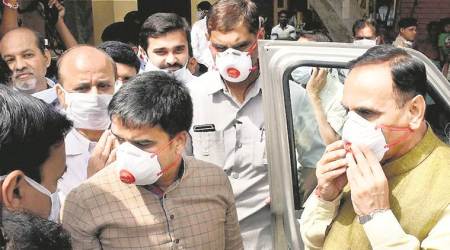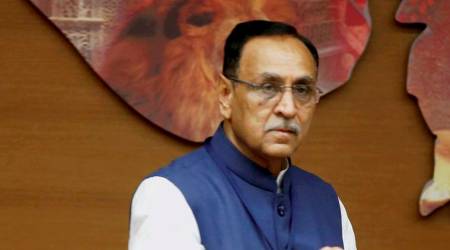 Gujarat reported as many as eight deaths and 192 fresh cases on Sunday. The situation this year is a repeat of 2015. (Express Photo by Javed Raja)
Gujarat reported as many as eight deaths and 192 fresh cases on Sunday. The situation this year is a repeat of 2015. (Express Photo by Javed Raja)
As many as 331 deaths and counting — Gujarat this year has witnessed one of the worse swine flu outbreaks since 2009, raising questions over the state government’s claim of preparedness to tackle the situation. While the health authorities continue to assure people that there was “nothing to panic” and everything was “under control”, the number of cases, 4,632 so far, and the deaths indicate otherwise. The state reported eight deaths and 192 fresh cases on Sunday.
With over 450 deaths, Maharashtra has been the worst affected state by the H1N1 influenza virus this year, but the situation in Gujarat was no better. Both the states have witnessed a repeat of the situation in 2015, the worst year since 2009 when a swine flu outbreak was first reported in the country. “The reason for Gujarat witnessing so many swine flu cases is that the state has the best surveillance system and higher reporting,” argued Dr Deepak Bhattacharya, one of the three experts who took stock of the swine flu situation in Gujarat from August 22 to 24.
The three-member expert team from the Centre — comprising Prof Lalit Dar, head of microbiology, All India Institute of Medical Sciences , Dr Bhattacharya, senior CMO of respiratory medicine, Safdarjung Hospital, and Dr Sanket Kulkarni, deputy director, epidemiology, National Center for Disease Control — was all praise for the way the state machinery responded to the swine flu outbreak. “Swine flu should now be called seasonal influenza” was among the team’s key suggestions.
Other health experts, however, countered the central team’s observations. “There is no preparedness or planning. In fact, the government is only focusing on lifestyle diseases because the onus goes on individuals when it comes to lifestyle diseases,”said Dr Leela Visaria, public health expert and former director of Gujarat Institute of Development Research. “ This time the pressure is more as it is an election year. The government has show that it was a regular outbreak, which has been dealt with efficiently.”
On August 16, the Gujarat High Court, on a plea seeking prompt measure to curb spread of swine flu virus, had asked the state government to list the measures that it has taken to deal with the outbreak. A bench headed by Justice M R Shah had told government’s law officers that while everything looked all right on paper, the reality was different.
On August 23, the Gujarat government replied to the High Court in an affidavit stating, “At present, influenza H1N1 is being treated as a seasonal influenza, meaning H1N1 virus has ceased to be a pandemic. The mortality rate has also been substantially reduced to 10 per cent from 16.8 per cent in 2009.”
MoS for Health and Family Welfare Shankar Chaudhary said: “We are putting together a detailed report and will present it soon to the court. There is nothing to panic as the state is taking all the measures to control the outbreak. It is seasonal flu and will reach a plateau soon. We have introduced a 104 fever helpline, ventilator management programmes for medical staff and increased the number of people working on anti-swine flu campaign.”
The health department authorities claimed that 17,000 teams have been involved in intensive door-to-door surveillance across the state with ASHA and anganwadi workers as well as malarial surveillance squads.
“Since the 2015 epidemic, we have seen many changes. This year we are observing cases of swine flu being reported with severe gastric disturbances. We have increased the diagnostic facilities this year… We have nine laboratories in government hospitals, while in 2015 there were only two. After it became a schedule H1 drug, even small pharmacy are allowed keep the anti-viral,” said Dr Bhavin Solanki, medical officer in-charge, Ahmedabad Municipal Corporation (AMC). “We have started our IEC (information, education, communication) from August. We have been airing video clips on six news channels since August 13 and radio jingles since August 16. We ensured that swine flu messages were shown at 104 cinema screens… 18 rickshaws with posters on swine flu roam around in slum areas. We have also started sending 74 lakh bulk SMSes daily to spread awareness in the city.”
Dr Kulandaisamy, director of public health in Tamil Nadu, told The Indian Express over phone: “While the logic of an aggressive campaign when the reporting of cases is high may appear convincing, for swine flu there has to be year-long campaigns, and tight surveillance. After the 2009 swine flu outbreak in Tamil Nadu, we designed campaigns, IEC materials and a surveillance system. We continued to monitor the spread of virus.” Tamil Nadu is leading the way in swine flu management as it ensured a low mortality rate year after year.
“We work on case management thoroughly. Once a case is reported, we focus on people living in the area and preventive action. We have also introduced audits of public spaces. We carry out random checks round the year,” said Dr Kulandaisamy.
Public health experts who have worked on bird flu, leptospirosis, malaria and plague in Gujarat claimed that there was no city in the country that publishes an annual cause of death report. Dr Kiran Desai, professor at Centre for Social Studies, Surat, said, “The government has all the explanation and figures when it comes to swine flu or any outbreak, but its own figures show that they are not doing a good job. Time and again experts say that public gathering should be avoided during flu outbreaks. But, there is no attempt to stop fairs and gatherings as it will affect the popularity of the government. Over the years epidemics have become political diseases.”

